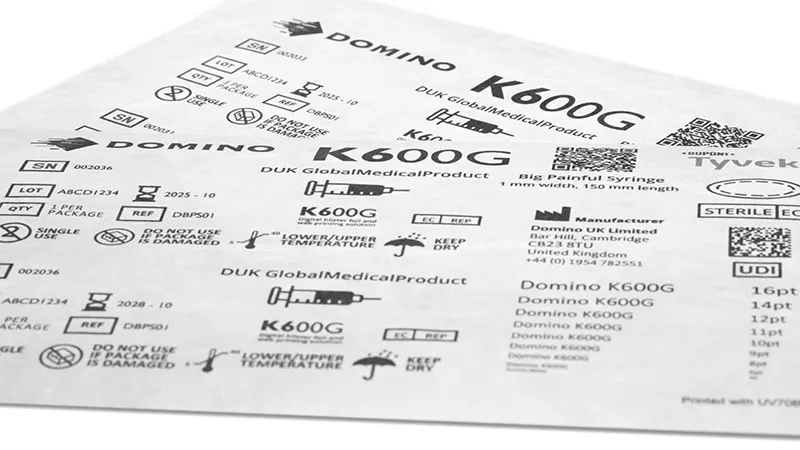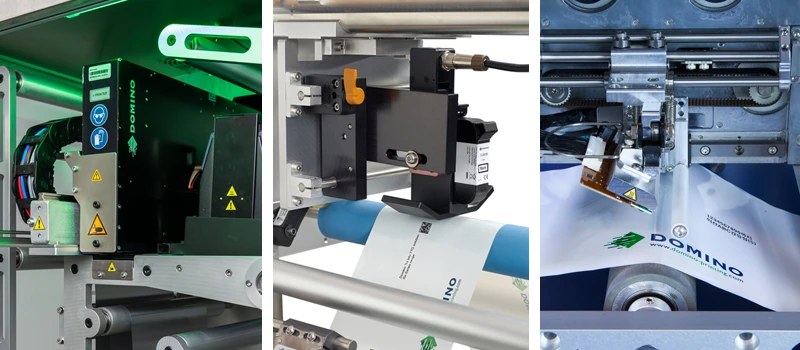Flexible packaging is a common sight in the medical device sector. This type of packaging offers several advantages: it’s flexible by definition making it suitable for a wide array of medical device shapes and sizes, ranging from surgical instruments to diagnostic kits; it also strikes a critical balance between durability and ease of use, helping to ensure that products remain sterile and safe, while being quick and easy to open at a moment’s notice.
As a medical device manufacturer looking to meet the stringent requirements of the healthcare industry, finding a coding and marking solution for printing on flexible medical packaging will be a top priority. In this blog, we will outline of the different types of flexible packaging types and provide some insight into the coding and marking options available, so you can make an informed choice.
Types of flexible medical packaging
Flexible medical packaging needs to provide a barrier against contaminants and withstand various sterilisation processes. Common materials include: plastic films such as polyethylene (PE) and polypropylene (PP); foil laminates; as well as coated paper-based materials.
Tyvek® from Dupont, a brand of flash spun high-density polyethylene fibres, is renowned for its durability, breathability, and microbial barrier performance, is one of the most popular brands of medical device packaging.

Coding requirements for medical devices
Accurate, clear, and durable product codes are an essential element of all medical device packaging, and are used for:
Compliance with regulatory standards: Regulations such as the EU Medical Device Regulations (EU MDR), require product specific printed on pack, including serial numbers, or unique device identifiers, and batch and expiration dates.
Traceability and inventory management: medical device manufacturers and supply chain partner can use item, and batch data, included in scannable 2D codes for efficient tracking and tracing of medical products within the supply chain.
Product identification and authenticity: for high-risk medical devices, serial numbers and 2D codes are a requirement to verify product authenticity, and protect patients from the risk of counterfeit products.
Patient communication and safety: product usage instructions and safety warnings may be printed directly on medical device packaging, to ensure safe and correct usage, and to protect patients and healthcare providers.

Printing technologies for flexible medical packaging
There are three main technologies predominantly used for printing on flexible medical device packaging:
As is always the case, there isn’t a ‘one size fits all’ solutions for printing on flexible medical packaging, the ideal solution will vary from production line to production line, and will depend on:
Production Speed: Production speed limitations exist for various printing technologies, encompassing both maximum and minimum operational speeds. Adhering to these speed limitations is crucial to ensuring optimal printing quality.
Printing Distance: All printing technologies have specific optimal printing distance characteristics. Maintaining an accurate printing distance is essential for producing high-quality codes.
Production line stability / vibration: Vibration and stability significantly impact both the printing technology and the media/product being printed. Poor stability can lead to fuzzy print outcomes and waviness due to product movement.
Packaging material: Not all packaging materials will be compatible with all technologies, with inks and consumables more suited to specific packaging types. In some cases, pre-treatment may be necessary to code adherence and longevity.
Identifying the ideal solution for printing on flexible medical packaging
A thorough analysis of specific production line requirements such as those outlined above, combined with precise, technical analysis of how substrates and inks interact in different environments, is key to achieving optimal code quality.

As part of Domino’s global approach to samples testing and analysis, our samples testing experts regularly engage in experimental printing and analysis of product packaging to identify potential solutions.
We employed several rigorous testing methodologies. These tests were designed to assess critical factors such as legibility, durability, and compliance with industry standards. Below, we detail the specific methodologies used in our evaluation for medical paper printing.
Visual Inspection: An essential step to objectively appraise the printed data. We focused on measuring the optical density of the print, which quantifies the darkness and clarity of the text and images. High optical density is vital for ensuring the legibility of critical information, such as dosage instructions and expiry dates, thereby meeting stringent industry standards.
Rub Resistance: To simulate the abrasion that printed pharmaceutical packaging undergoes during transportation and handling, we performed a rub resistance test. This involved subjecting the printed material to 1,600 cycles of rubbing with a crocking cloth. The procedure replicated the friction experienced by packages in real-world scenarios. The objective was to ensure that the print remained legible and intact, preventing any compromise of essential information.
Scratch Resistance: In addition to rub resistance, we assessed the scratch resistance of the printed materials. Our scratch resistance test involved subjecting the printed surface to 50 cycles with a 12-micron 3M lapping film using a crockmeter. This test was designed to evaluate the print’s durability against scratches that might occur during handling and transportation. Maintaining scratch resistance is crucial for preserving the integrity and readability of critical information on pharmaceutical packaging.
Steam Sterilization: Given that pharmaceutical products often undergo sterilization to eliminate contaminants, it is imperative to assess the impact of this process on printed materials. Our steam sterilization test evaluated how well the print responded to autoclave sterilization conditions, which included high temperatures (121 degrees Celsius), high pressure, and high humidity for 60 minutes. The goal was to ensure that the print could withstand these harsh conditions without degrading or losing legibility, thus maintaining the readability of critical information throughout the product's lifecycle.
Scan Testing: In the pharmaceutical supply chain, the accuracy of barcode and 2D code scanning is essential for tracking and verifying products. Our scan testing involved evaluating the readability of these codes using standard barcode scanners. This test ensured that the codes could be accurately scanned and interpreted, facilitating efficient inventory management and enhancing traceability and security throughout the distribution process.
What is the best solution?
On 1073B DuPont Tyvek®, Domino BK118 and BK129 gave really good results in general. Both Rub grade B and Steam grade C with good steam sterilisation result.
On 1059B DuPont Tyvek®, the best results were from BK118 with Very good on Visual Inspection and Rub resistance and A in Control Grade and Rub Grade, and C in Steam grade. BK129 was very good on visual control and Rub grade but the Steam Grade was suboptimal.
In general, Piezo drop-on-demand technologies and inks performed very well on Tyvek®. Both water-based and UV cure inks produced consistently good results, receiving an A grade in all tests. The optical density ranged from 0.74 to 0.89.
Among all the inks for thermal Inkjet, BK129 produced the best results, especially on the 1059B surface. While BK652 showed good visual results, subsequent tests revealed irregular performance.
The thermal transfer ribbon generally performed well, achieving an optical density between 1.21 and 0.88 after the rub and autoclave tests.
TTO provides the highest optical density but at the slowest printing speed, TIJ offers a good all-round result but with a small print footprint and PIJ provides full print capabilities at high speed and good print density but at a higher capital cost.
Conclusion
The range of results, material handling and production environment clearly confirms that there is no “one size fits all” solution for flexible medical packaging, however through consultation with customers, detailed analysis and testing of materials and development of bespoke solutions, it is possible to install and print variable data in the most challenging flexible medical packaging environments.